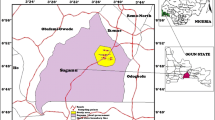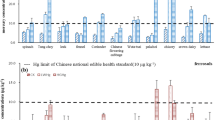Abstract
Heavy metals in the soil–plant system resulting from mining and wastewater irrigation have greatly threatened human health and sustainable development in Northwest China. This research used pot experiments to study the bioavailability of Cd in irrigated desert soil from the oasis regions and conducted a human health risk assessment of the Cd content in vegetables. The results show that the content of Cd associated with exchangeable and carbonate metal fractionations is not uniform in arid oasis soils cultivated with the commonly grown vegetables. These common growth vegetables are: Cole (Brassica campestris L.), Celery (Apium Graveolens L.) and carrots (Daucus carota L.). The results show that the content of Cd in the edible part of cole was significantly higher than celery and carrots in almost all of the treatments. However, cole can grow normally and keep increasing its biomass at a sustainable rate under the highest concentration of Cd added in the experiment. Cole is not a suitable vegetable to be planted for consumption in arid soil contaminated with Cd, celery planted under lower concentration of Cd will not threaten human health, and carrots are suitable to be planted in arid soil contaminated with Cd even in the highest concentration used in the experiment. According to this conclusion, stricter soil management systems should be implemented to protect arid land soil resources and to protect human health from the toxicity impacts.




Similar content being viewed by others
References
Ahumada I, Mendoza J, Navarrete E, Ascar L (1999) Sequential extraction of heavy metals in soils irrigated with wastewater. Commun Soil Sci Plant Anal 30:1507–1519
Alexander PD, Alloway BJ, Dourado AM (2006) Genotypic variations in the accumulation of Cd, Cu, Pb and Zn exhibited by six commonly grown vegetables. Environ Pollut 144:736–774
Greger M, Malm T, Kautsky L (2007) Heavy metal transfer from composted macroalgae to crops. Eur J Agron 26:257–265
Guerra P, Ahumada I, Carrasco A (2007) Effect of biosolid incorporation to mollisol soils on Cr, Cu, Ni, Pb, and Zn fractionation, and relationship with their bioavailability. Chemosphere 68:2021–2027
Han FX, Kingery WL, Hargreaves JE, Walker TW (2007) Effects of land uses on solid-phase distribution of micronutrients in selected vertisols of the Mississippi River Delta. Geoderma 142:96–1002
Krishnamurti GSR, Naidu R (2003) Solid–solution equilibria of cadmium in soils. Geoderma 113:17–21
Lakhdar A, Iannelli MA, Debez A, Massacci A, Jedidi N, Abdelly C (2010) Effect of municipal solid waste compost and sewage sludge use on wheat (Triticum durum): growth, heavy metal accumulation, and antioxidant activity. J Sci Food Agric 90:965–971
Li Y, Wang Y, Gou X, Su YB, Wang G (2006) Risk assessment of heavy metals in soils and vegetables around non-ferrous metals mining and smelting sites, Baiyin, China. J Environ Sci 18:1124–1134
Nan ZR, Zhao CY (2000) Heavy metal concentrations in gray calcareous soils of Baiyin region, Gansu province, PR China. Water Air Soil Pollut 118:131–141
Oskarsson A, Widell A, Olsson IM, Petersson Grawe K (2004) Cadmium in food chain and health effects in sensitive population groups. Biometals 17:531–534
Patra J, Lenka M, Panda BB (1994) Tolerance and co-tolerance of the grass Chtorisbarbata to mercury, cadmium and zinc. New Phytol 128:165–171
Qiao XL, Luo YM, Christie P, Wong MH (2003) Chemical speciation and extractability of Zn, Cu and Cd in two contrasting biosolids-amended clay soils. Chemosphere 50:823–929
Sang H, Eul Y, Seunghun H, Jeongm G (2009) Metal availability in heavy metal-contaminated open burning and open detonation soil: assessment using soil enzymes, earthworms, and chemical extractions. J Hazard Mater 170:382–388
Santos A, Alonso E, Callejon M, Jimenez JC (2002) Heavy metal content and speciation in groundwater of the Guadiamar river basin. Chemosphere 48:279–285
Tessier A, Campbell PGC, Bisson M (1979) Sequential extraction procedure for the speciation of particulate trace metals. Anal Chem 51:844–851
Zheljazkov VD, Nielsen NE (1996) Effect of heavy metals on pepper mint and cornmint. Plant Soil 178:59–66
Acknowledgments
This work was supported by the Fundamental Research Funds for the Central Universities in Lanzhou University (lzujbky-2011-132). The Affections of Climate Change on Desertification and Risk Assessment Techniques (2012BAC19B09) and the Natural Science Foundation of China (No. 51178209 and No. 91025015).
Author information
Authors and Affiliations
Corresponding author
Rights and permissions
About this article
Cite this article
Wang, X., Ding, W., Nan, Z. et al. Fraction of Cd in oasis soil and its bioavailability to commonly grown crops in Northwest China. Environ Earth Sci 70, 471–479 (2013). https://doi.org/10.1007/s12665-013-2374-3
Received:
Accepted:
Published:
Issue Date:
DOI: https://doi.org/10.1007/s12665-013-2374-3




